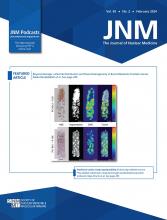In their article entitled “The Imperative for Comparative Studies in Nuclear Medicine: Elevating 177Lu-PSMA-617 in the Treatment Paradigm for mCRPC” in The Journal of Nuclear Medicine, Rahbar et al. make some important comments (1).
On behalf of the coauthors of the PSMAfore presentation at the 2023 congress of the European Society for Medical Oncology (2) in Madrid, we fully agree with Rahbar et al. that the landscape of metastatic castration-resistant prostate cancer (mCRPC) treatment is evolving rapidly and that nuclear medicine treatments have a significant role to play. As indicated by Rahbar et al., PSMAfore is not a perfect study that addresses all clinical questions—as indeed few are.
Many factors go into clinical trial design considerations, and we welcome the opportunity to discuss some of the critical factors involved when the PSMAfore trial was constructed. The use of 177Lu-PSMA-617 in the mCRPC setting had already proven to be effective in the posttaxane, post–androgen receptor pathway inhibitor (ARPI) mCRPC setting as demonstrated by the phase III VISION trial (3). The VISION results led to widespread regulatory approvals.
Although VISION was clearly positive in this advanced setting, several criticisms were noted. First there was no crossover, and second patients were required to receive taxane before randomization. In addition, some criticized the nontaxane control arm, though approximately 40% of the patients had already received 2 taxane treatments.
The PSMAfore trial was designed to explore the activity of 177Lu-PSMA-617 in an earlier mCRPC disease setting. In this case, the inclusion and exclusion criteria excluded prior taxane use unless applied in the adjuvant or neoadjuvant setting more than 1 y before trial enrollment. In addition, crossover to the isotopic therapy was allowed after documented radiographic progression on the control arm.
Docetaxel could be a logical comparator from several perspectives despite the fact that docetaxel has never been proven to be superior to a competitor in a randomized trial in the post-ARPI mCRPC space. Real-world data indicate that docetaxel use is limited in many counties in the mCRPC setting, especially as the first therapeutic choice in the initial post-ARPI mCRPC setting (4–6). As Rahbar et al. are likely aware, when given a choice, many physicians and patients clearly do not choose docetaxel as the initial treatment in the post-ARPI mCRPC disease state (4,5). The reasons for this choice are multifold, including dislike of the side effect profile of chemotherapy; progression declared by a rising prostate-specific antigen level only, without significant clinical or radiographic progression; the potential for long-term responsiveness to androgen-receptor–directed therapies; low disease burdens; and oligoprogressive disease, to name a few. The control arm of PSMAfore follows a common, real-world treatment paradigm.
We further note that all prerandomization patients could receive chemotherapy before entering the trial. If a taxane was deemed appropriate, patients and their physicians could readily choose that option and potentially receive commercial 177Lu-PSMA-617 at a later date.
After randomization, if chemotherapy was deemed appropriate, patients and their physicians could choose that option at any time in either arm. Few chose that option. We note that a randomized phase II trial assigning post-ARPI, post-docetaxel patients to 177Lu-PSMA-617 versus cabazitaxel found similar survival between the two arms but less adverse events with the isotope (7).
Other agents besides docetaxel might also be appropriate in selected patients in the post-ARPI mCRPC space. For instance, those with certain DNA repair defects may benefit from PARP inhibitors (8). These patients were required to seek such treatments rather than be randomized in the PSMAfore trial.
It is of notable interest that the patients enrolled in the PSMAfore trial were thought to be suitable for a second ARPI treatment by the enrolling investigators. The median radiographic progression-free survival in PSMAfore was 5.59 mo in the hormonal treatment arm. This compared with the median radiographic progression-free survival of 4.1 mo for the enzalutamide arm of the IMbassador250 trial (9), another post-ARPI mCRPC trial that did not allow taxanes in the control arm, suggesting indeed that patients with more indolent disease (and thus unlikely to be good candidates for immediate docetaxel) may have been selected to participate in PSMAfore. Another characteristic likely indicating the same selection phenomenon is the low incidence of visceral disease (3% liver metastases in the control arm) in men included in the trial.
The use of 177Lu-PSMA-617 crossover for those randomized to the control arm, once they met the radiographic progression-free survival endpoint, further ensured the ethical nature of the trial. Given that 84.2% of the ARPI control arm patients eligible for crossover actually received 177Lu-PSMA-617, most patients eligible for crossover actually received the isotopic therapy.
Taken together, the PSMAfore trial design carefully considered the suitability of patients for both arms of the trial. The trial enrolled briskly, indicating the acceptable nature of the trial design to both investigators and patients alike. Before and after randomization, various options were available to the patients, and choices were made to ensure that patient safety was a priority. Crossover was enthusiastically embraced in those with progression on the ARPI arm. We hope that these considerations may be more apparent to critics of the trial.
- © 2024 by the Society of Nuclear Medicine and Molecular Imaging.
REFERENCES
- Received for publication November 28, 2023.
- Revision received January 5, 2024.







